João Maria Condeixa, External & Policy Affairs Manager at Janssen, a pharmaceutical company part of the Johnson & Johnson group
The race for the vaccine we are currently witnessing would not be possible without science, without years of continuous investment and gathered knowledge and without intense collaboration, at an unprecedented level. But it’s not just a race. We witnessed and are now still witnessing a number of races against time.
First, the basic research race, thanks to which we were able to decode the SARS-CoV-2 virus genome. On the last day of December 2019, Chinese authorities formally warned the World Health Organization (WHO) as to the existence of a new virus. On January 10, 2020, the genetic code of this virus, formed by 30,000 characters, was fully decoded. Until ten years ago, genetic sequencing was both time consuming and very expensive. Back in 2001, the cost to decode the human genome was $ 1 billion and today this can be done fairly quickly for just over $ 1,000. The fantastic advances in genetic sequencing have enabled decoding this virus in record time and to start the development of the vaccine from there.
It usually takes 10 to 15 years to develop a vaccine. As regards this vaccine, just like the previous, no shortcuts were taken, no steps were skipped, although records were broken thanks to the following reasons: a huge investment in financial and human resources, with vast teams focused exclusively on this topic. Not least, the enormous collaboration between pharmaceutical companies and between these and regulators and decision makers – the “Rolling review” mechanism created by the European Medicines Agency (EMA) is a good example of this. Instead of waiting for the gathering and submission of all the data produced, EMA assessed us as the data were made known. It was important to take this process into the future.
Equally relevant was the investment and experience gathered over decades with other pandemics, namely Ebola, HIV, Zika, SARS-CoV or MERS. In the case of Ebola, 27 years elapsed since the beginning of the pandemic until entering phase I clinical trials. As for Dengue it took 39 years and Zika 9. As for SAR-Cov it took 24 months and as for MERS, in 2014, only took 22 months. A continuous improvement that reached its peak in this pandemic whereby 3 months only elapsed from the breakout to the beginning of phase I of clinical trials.
In mid-February this year, WHO had 21 vaccines in pre-clinical trials. And by mid-December, 214 candidate vaccines had already been registered, of which 52 were undergoing clinical trials in humans. It was both the prompt response and the intense collaboration between nations that allowed this fantastic gain.
The race for clinical trials was equally intense, with countless countries applying and an unparalleled universe of interested volunteers. These trials took place in the regions with the highest incidence and in countries with the best level of success thanks to the agile performance of trials. Portugal, unfortunately, is still not competitive as regards attracting trials. There is still a road that needs to be travelled in order to improve the appeal of clinical trials that are of interest both clinically and financially to the country. We need hospital teams dedicated to this topic and greater agility in the red tape it requires if we want to become an active party in the future, whatever the disease. Patients are waiting.
Finally, we are witnessing a solidarity race that is also worth looking at. European countries were quick in setting up a fund for the purchase of vaccines and also in providing for a mechanism and acquisition of doses for developing countries. The big nations came together to ensure that the poorest would also have access to this solution. The pharmaceutical companies themselves, as they moved on in producing the vaccine at their own risk, established most of them that they would not profit during the pandemic period and some established reserves to the poorest countries – Johnson & Johnson, for example, as in the week when I wrote this text had donated 500 million doses to the most disadvantaged countries.
And now, we watch the race for vaccination, confident that there will be the light at the end of the tunnel.
Innovation and collaboration are the key to this pandemic. Without them, the vaccine would not arrive and the global impact on the GDP would be $3.5 trillion dollars, according to recent studies. And even with a vaccine, should this access only be granted to producing or wealthier countries, the economic impact would translate into a decrease of around 1.2 trillion dollars of world GDP.
Thus, in addition to the added value that innovation brings to society, there is also the importance of working together to improve access to innovation. This is one of the big lessons of these times. Whether as regards this or other diseases, this lesson should be recalled in the future.







